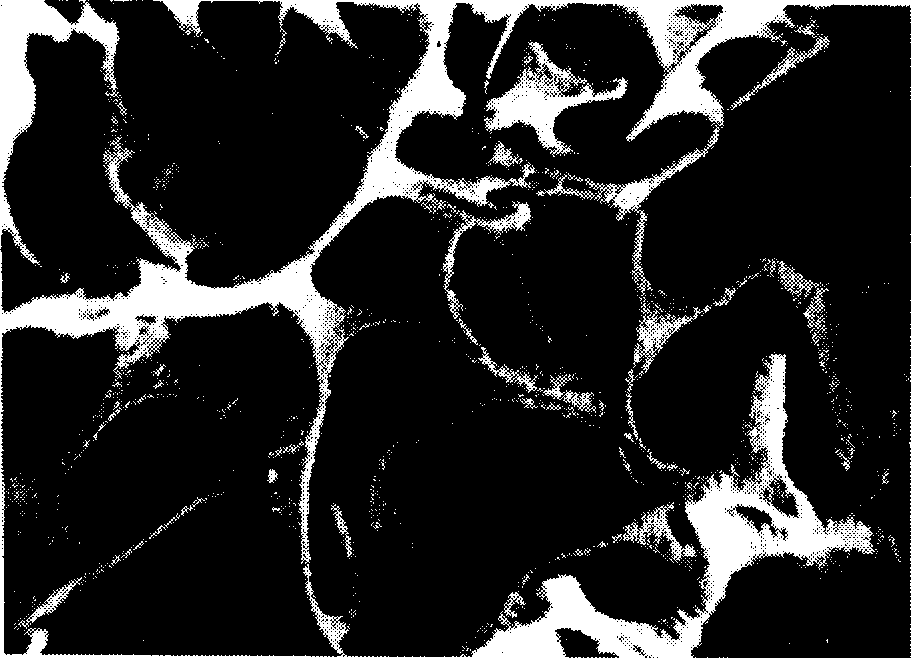Three-dimensional electrode for accummulater and preparing mehtod
A storage battery and electrode technology, which is applied in the field of three-dimensional porous electrode materials to manufacture such three-dimensional porous electrodes, can solve the problems of increasing and not effectively improving the surface area of micropores, and achieve high discharge rate, good continuity of mechanical and electrical properties , the effect of shortening the initial capacity
- Summary
- Abstract
- Description
- Claims
- Application Information
AI Technical Summary
Problems solved by technology
Method used
Image
Examples
Embodiment 1
[0027] Example 1 Mechanically mix polytetrafluoroethylene, zeolite and sodium metasilicate at a ratio of 13:6:1, put it into a mold and press at 100-300°C for 2-5 minutes to release the mold; put it into a heating furnace at 100- Sintered at 300°C to form a 590-74um microporous material to form a three-dimensional electrode matrix; the lead is embedded in the three-dimensional electrode matrix by vibration. Particles are firmly embedded. Using the chemical plating method, the three-dimensional matrix material is attached to the conductive layer, the diameter of the mesh is kept at 590-74 microns, and the inlaid particles are integrated with the mesh matrix to form a three-dimensional body. Put the three-dimensional body into an oxygen furnace and fill it with pure oxygen for 15 to 60 minutes, so that the inner wall of the three-dimensional hole is oxidized to form a layer of electrochemically active material; the active material is coated on the battery plate by paste, The th...
Embodiment 2
[0028]Example 2: Ultra-high molecular weight polyethylene (2 million molecular weight), zeolite and sodium metasilicate are mechanically mixed in a ratio of 13:6:1, put into a mold, and hot-pressed at 100-300°C for 2-5 minutes to release the mold; The heating furnace is fired at 100-300°C to form a 590-74um microporous material to form a three-dimensional electrode matrix; lead is embedded in the three-dimensional electrode matrix by mechanical coating, and the non-metallic material of the three-dimensional network matrix accounts for 42% of the volume of the active material. Then it is squeezed by the roller to achieve the firm inlay of the particles. Using the chemical plating method, the three-dimensional matrix material is attached to the conductive layer, the mesh diameter is kept at 590-74 microns, and the inlaid particles are combined with the mesh matrix to form a three-dimensional body. Put the three-dimensional body into an oxygen furnace and fill it with pure oxygen...
Embodiment 3
[0029] Example 3: Mechanically mix polyethylene, zeolite, activated carbon and polytetrafluoroethylene emulsion at a ratio of 12:3:3:1, put them into a mold and heat press for 2 to 5 minutes to demould; The 74um microporous material forms a three-dimensional electrode matrix; the lead is embedded in the three-dimensional electrode matrix by mechanical coating, and the non-metallic material of the three-dimensional network matrix accounts for 50% of the volume of the active material. Then it is squeezed by the roller to achieve the firm inlay of the particles. Following preparation method is with embodiment 1.
PUM
| Property | Measurement | Unit |
|---|---|---|
| Pore diameter | aaaaa | aaaaa |
Abstract
Description
Claims
Application Information
 Login to View More
Login to View More - Generate Ideas
- Intellectual Property
- Life Sciences
- Materials
- Tech Scout
- Unparalleled Data Quality
- Higher Quality Content
- 60% Fewer Hallucinations
Browse by: Latest US Patents, China's latest patents, Technical Efficacy Thesaurus, Application Domain, Technology Topic, Popular Technical Reports.
© 2025 PatSnap. All rights reserved.Legal|Privacy policy|Modern Slavery Act Transparency Statement|Sitemap|About US| Contact US: help@patsnap.com

